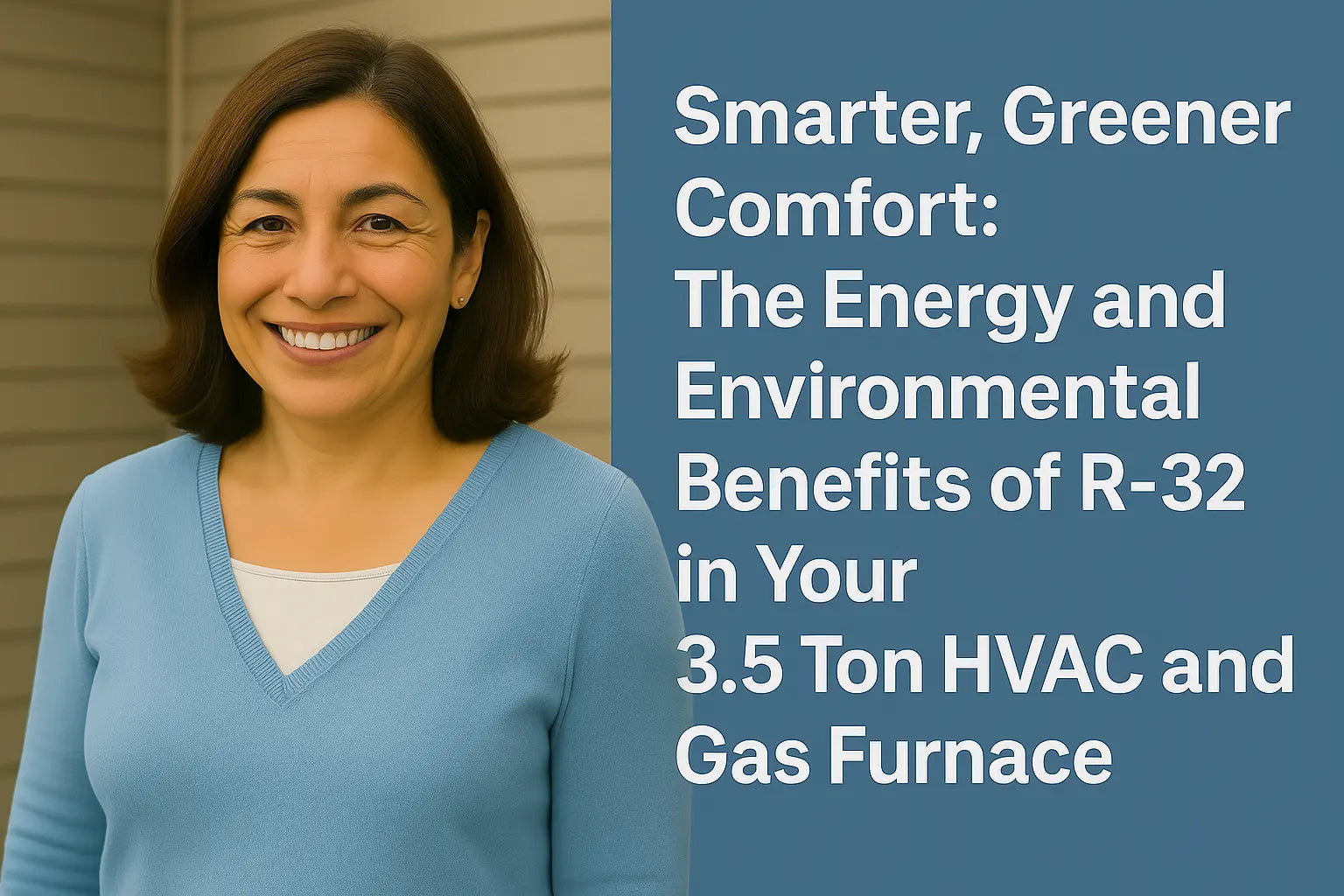Hi Again, Friends! 👋 It’s Samantha
Let’s talk about something near and dear to my heart (and probably your wallet too): energy efficiency and sustainability.
When I first switched to an R-32 AC and gas furnace system, I didn’t realize just how much of a difference one change in refrigerant could make. I knew it was supposed to be “greener,” but once I dug into the numbers—both environmental and financial—I was genuinely impressed.
So in this post, I’m going to walk you through what makes R-32 refrigerant such a smart upgrade, how it stacks up against older options like R-410A, and why your 3.5 ton system is a powerful tool for cutting costs and carbon. Let’s dive in!
What Is R-32 and Why Should You Care?
R-32 is a next-generation refrigerant developed to replace older, higher-impact refrigerants like R-410A. While refrigerants are essential to air conditioning, many traditional types have contributed significantly to greenhouse gas emissions due to their high global warming potential (GWP).
Let’s break it down:
-
R-410A GWP: 2,088
-
R-32 GWP: 675
(Source: EPA GWP Fact Sheet)
That’s nearly a 70% reduction in climate impact just by changing the refrigerant. R-32 is also more energy efficient, which means your system uses less electricity to cool your home. That’s a win for your budget and the planet. 🌎
Energy Efficiency: How R-32 Helps Lower Your Utility Bills
Here’s where the smart shopping rubber meets the road.
R-32 has superior thermal conductivity.
This means it transfers heat more efficiently, allowing your 3.5 ton system to do the same job using less energy. Less energy = lower bills = more 🤑 in your pocket.
In fact, systems using R-32 can operate at up to 10% greater efficiency than comparable R-410A units, according to Daikin’s technical analysis.
R-32 systems are designed with smarter compressors.
Newer systems are built around R-32’s unique properties, which often results in more advanced inverter technology, tighter refrigerant control, and fewer emissions from energy waste.
A properly installed 3.5 ton R-32 system, like those at The Furnace Outlet, can help reduce your annual cooling costs by $200–$500 per year, depending on local utility rates and home insulation. 🧾💡
Lower Carbon Footprint with Every Cycle
Most homeowners don’t think about refrigerant until something goes wrong, but it plays a huge role in our global climate.
The UN Montreal Protocol has long guided countries to phase down high-GWP refrigerants—and the U.S. is finally catching up. R-32 helps meet those goals by:
-
Requiring less volume for the same cooling effect
-
Reducing emissions when leaks occur
-
Aligning with AIM Act regulations from the EPA for cleaner refrigerant standards
So every time your 3.5 ton R-32 unit cycles on, you’re helping shift the HVAC industry toward sustainability. How cool is that? (Literally.)
R-32 vs. R-410A: The Real Comparison
Here’s a quick snapshot of how the two stack up:
| Feature | R-32 | R-410A |
|---|---|---|
| Global Warming Potential | 675 | 2,088 |
| Energy Efficiency | Higher (≈10% more) | Standard |
| Flammability | Mildly flammable (A2L) | Non-flammable |
| Charge volume needed | Lower | Higher |
| System Pressure | Slightly higher | High |
| Long-Term Viability | Yes – future-friendly | Being phased down |
Many homeowners ask about flammability—yes, R-32 is mildly flammable, but it’s been proven safe for residential use with proper installation, and is widely used in over 100 million systems globally. Learn more about that at National Refrigerants Inc's R-32 safety report.
Is R-32 Right for Your Home?
If you’ve got a medium-size home (roughly 1,800–2,400 square feet), a 3.5 ton R-32 AC and gas furnace system is a great choice:
-
It’s perfectly sized for balanced cooling and heating
-
It uses less refrigerant and electricity
-
It aligns with future refrigerant standards so you won’t need to upgrade again soon
-
It’s often more affordable long-term, thanks to lower maintenance and energy costs
Whether you’re upgrading from an older R-22 or R-410A system or building from scratch, it’s a step forward in comfort and responsibility.
Bonus: R-32 Systems May Qualify for Rebates 💰
Because R-32 systems are energy-efficient and low-emission, they can qualify for local utility rebates, tax credits, or federal energy incentives. These vary by region, but it’s worth checking with your utility company or browsing DSIRE’s energy incentive database to see what’s available in your area.
Rebates can add up to hundreds—or even thousands—of dollars back in your pocket.
Final Thoughts from Samantha 🌟
If you’ve been on the fence about switching to R-32, I hope this helped clear things up. It’s not just a buzzword—it’s a better, more efficient way to keep your home comfortable and help the planet.
And hey, if you’re ready to shop for your own energy-smart system, I highly recommend checking out the R-32 3–5 ton AC and gas furnace systems at The Furnace Outlet. These matched bundles take the guesswork out of choosing the right system—and they ship fast.
Don't know which of these systems to pick? Visit my guide: Choosing the Right 3.5 Ton R-32 AC and Gas Furnace System for Your Home.
Stay smart, stay cool, and keep being part of the solution. 🌍💚
— Samantha, Home Comfort Advisor







